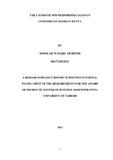| dc.contributor.author | Muriithi, Monicah W | |
| dc.date.accessioned | 2013-11-12T07:09:32Z | |
| dc.date.available | 2013-11-12T07:09:32Z | |
| dc.date.issued | 2013 | |
| dc.identifier.citation | Degree in Master of Business Administration | en |
| dc.identifier.uri | http://erepository.uonbi.ac.ke:8080/xmlui/handle/123456789/58567 | |
| dc.description | A Research Project Report Submitted In Partial Fulfillment of the Requirements for the Award of Degree of Master of Business Administration | en |
| dc.description.abstract | The objective of the study was to determine the causes of Non-Performing loans in Commercial Banks in Kenya. Non-Performing loans is widely associated with bank failure and financial crises for commercial banks in Kenya. Due to the nature of their business, commercial banks expose themselves to the risks of default from borrowers. The eradication of NPL’s is a necessary condition to improve the economic status and stability of the banking sector. If the Non-Performing loans are kept existing and continuously rolled over the resources are locked up in unprofitable sector; thus hindering the economic growth and impairing the economic efficiency.
The study adopted the Descriptive Design and applied both multiple regression models on secondary data to determine the relationship between causes of Non-Performing Loans in Commercial Banks in Kenya. The study used secondary data for the period 2008-2012. The Interest rates, Inflation and growth in loans were used as independent variables. Non-performing loan was used as dependent variable. The population of this study comprised of 43 commercial banks in Kenya and data was analyzed using SPSS.
The study revealed that non-performing loans of commercial banks in Kenya are positively correlated with inflation rate (0.316). The study also found that non-performing loans are negatively correlated with real interest rate (-0.468) and growth rate in loans (-0.013) respectively. Further the study indicated that the study variables jointly influenced the non performing loans with an adjusted R2 of 0.553. This means that 55.3% of variation in the dependent variable in the regression model is due to independent variables while 44.7% are due to error term, chance or unexplained. The F- Statistics of 23.409 was also significant. The model was therefore considered robust or fitted well to the actual data of the variables. The study concludes that the independent variables considered in the study jointly caused the non-performing loans in commercial banks in Kenya. The study also found that the non-performing loans were positively correlated to inflation rate. The study further concludes that non-performing loans are negatively correlated with real interest rate and growth rate in loans in Kenya. The objective of the study, which was to determine the causes of non-performing loans in commercial banks in Kenya, was therefore met. The study recommends that in order for the commercial banks in Kenya to improve, there is need for the Government to initiates measures that will control the real interest rate in Kenya. Lower interest rates would be more appropriate in order to reduce the level of non-performing loans in Kenya since they are negatively correlated with ratio of non-performing loans. The study also recommends that there is also need for the Government to control the inflation rate in Kenya as there is some evidence to suggest that low will lead to better performance of loans in Kenya. The study further recommends that there is need for the commercial banks to initiate policies that will control the amount of loans they have. | en |
| dc.language.iso | en | en |
| dc.publisher | University of Nairobi | en |
| dc.title | The Causes of Non-performing Loans in Commercial Banks in Kenya | en |
| dc.type | Thesis | en |
| local.publisher | School of Business | en |

